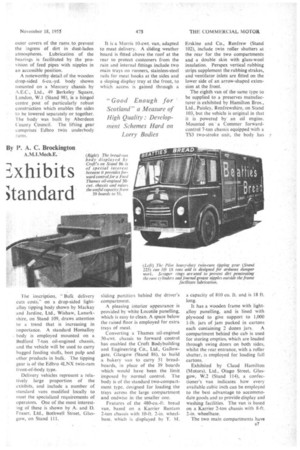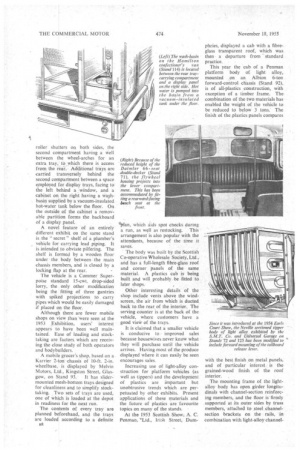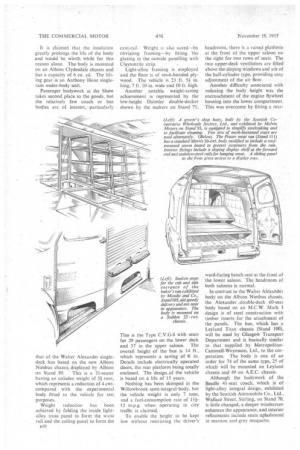Glasgow Bod =2xhibits Set a Higi ;tandard
Page 40

Page 41

Page 42

Page 43

Page 44

If you've noticed an error in this article please click here to report it so we can fix it.
T0 many Scottish bodybuilders, the exhibition at Kelvin Hall
provides an unparalleled opportunity to display their products to potential users who have a first-hand knowledge of the arduous operating conditions of the surrounding country, and exhibitors coming from ' south of the Border know that the questions asked on their stands will be searching and pertinent, "Good enough for Scotland" may be taken as a yardstick of fine quality.
Vehicles employed for the many development schemes in the area include a large proportion of tippers, which are subjected to such severe use that any shortcoming is normally discovered in the first few weeks of operation.
It is, therefore, to the outstanding credit of the Neville light-alloysection body, the prototype of which was exhibited at the 1954 Earls Court Show, that a number has stood the test of extremely rough site work in Scotland. In one instance, an overload fractured the vehicle chassis arid distorted the body so much that the latter was at first considered a write-off, but was employed on another chassis without repair.
n6
Versions of the body, or sections of it, are displayed on three stands, including those of the S.M.T. Sales and Service Co., Ltd., 39 Fountainbridge, Edinburgh (Stand 72), on .which the chassis is a Bedford shortwheelbase 7-tonner, and Universal Garage (Glasgow), Ltd., Alexandra Parade, Glasgow (Stand 125), where the body can be seen mounted on a Guy Otter 6-tanner.
" Modifications made since its introduction include the use of swaged panels for the tail and head boards, reinforced with top-hat sections, and the provision of a tailboard release lever at the forward end. The body sections are now available in material of heavier gauge, and the number of reinforcing support plates can be increased as required to stiffen the structure.
The body on the Bedford chassis has a capacity of 6 cu. yd., whilst the largest body so far constructed is capable of carrying 14 cu. yd.
It is appropriate that the single exhibit displayed by Pilot Works, Ltd., Bolton, on Stand 225, should be the latest heavy-duty tipping gear with a lifting capacity of 18 tons, which was developed for large dumpers. This is of the twin-ram underbody type with a massive lifting cradle, which provides a large journal area and distributes the 'toad over a large part of the body underframe.
Scraper rings are fitted inside the
The inscription, "Bulk delivery cuts costs," on a drop-sided lightalloy tipping body shown by Mackay and Jardine, Ltd., Wishaw, Lanarkshire, on Stand 109, draws attention to a trend that is increasing in importance. A standard Homalloy body is employed mounted on a Bedford 7-ton oil-engined chassis, and the vehicle will be used to carry bagged feeding stuffs, beet pulp and other products in bulk. The tipping gear is of the Edbro 4LNX twin-ram f ront-ofthody type.
Delivery vehicles represent a relatively large proportion of the exhibits, and include a number of standard vans modified locally to meet the specialized requirements of operators. One of the most interesting of these is shown by A. and D. Fraser, Ltd., Bothwell Street, Glasgow, on Stand III. It is a Morris 10-cwt. van, adapted to meat delivery. A sliding weather board is fitted above the roof at the rear to protect customers from the rain and internal fittings include two main trays on runners, stainless-steel rails for meat books at the sides and a sloping display tray at the front, to which access is gained through a sliding partition behind the driver's a capacity of 810 Cu. ft. and is 18 ft.
compartment.
A pleasing interior appearance is provided by white Locotile panelling, which is easy to clean. A space below the raised floor is employed for extra trays of meat.
Converting a Thames oil-engined 30-cwt. chassis to forward control has enabled the Croft Bodybuilding and Engineering Co., Ltd., Gallowgate, Glasgow (Stand 86), to build a bakery van to carry 51 breadboards, in place of the 39 boards which would have been the limit imposed by normal control. The body is of the standard two-compartment type, designed for loading the trays across the large compartment and endwise in the smaller one.
Features of the 480-cu.-ft. bread van, based on a Karrier Bantam 2-ton chassis with JO-ft 2-in, wheelbase, which is displayed by T. M.
Erskine and Co., Renfrew (Stand 102), include twin roller shutters at the rear for the two compartments and a double skin with glass-wool insulation. Perspex vertical rubbing strips supplement the rubbing strakes, and ventilator inlets are fitted on the lower side of an arrow-shaped extension at the front.
The eighth van of the same type to be supplied to a 'preserves manufacturer is exhibited by Hamilton Bros., Ltd., Paisley, Renfrewshire, on Stand 103, but the vehicle is original in that it is powered by an oil engine. Mounted on a Commer forwardControl 7-ton chassis equipped with a TS'3 two-stroke unit, the • body has It has a wooden frame with lightalloy panelling, and is lined with plywood to give support to 1,000 1-1b. jars of jam packed in cartons each containing 2 dozen jars.. A compartment behind the cab is used for storing empties., which are loaded through swing doors on both sides, whilst the rear entrance, with a roller shutter, is employed for loading full cartons.
Exhibited by Claud Hamilton (Motors), Ltd., Otago Street, Glasgow, W.2 (Stand 114), a confectioner's van indicates how every available cubic inch can be employed to the best advantage to accommodate goods and to provide display and washing facilities. The van is based on a Karrier 2-ton chassis with 8-ft. 2-in. wheelbase.
The two main compartments have 137
roller shutters on both sides, the second compartment having a well between the wheel-arches for an extra, tray," to which there is access from the rear: Additional trays are carried transversely behind the second compartment between a space employed for display trays, facing to the left behind a window, and a cabinet on the right having a washbasin supplied by a vacuum-insulated hot-water tank below the floor. On the outside of the cabinet a removable partition forms the backboard of a display panel.
A novel feature of an entirely different exhibit, on the same stand is the " secret " shelf of a plumber's vehicle for carrying lead piping. It is intended to obviate pilfering. The shelf is formed by a wooden floor under the body between: the main chassis members, and is closed by a locking flap at the rear.
The vehicle is a Commer Superpoise standard 15-cwt. drop-sided lorry, the only other modification being the fitting of three gantries with spiked projections to , carry pipes which would be easily damaged if placed on the floor.
Although there are fewer mobile shops on view than were seen at the 1953 Exhibition, users' interest appears to have been well maintained. Ease of loading and stocktaking are factors, which are receiving the close study of both operators and bodybuilders.
A mobile grocer's shop, based on a Karrier 2-ton chassis of 10-ft. 2-in. wheelbase, is displayed by Melvin Motors, Ltd., Kingston Street, Glasgow, on Stand 93.. It has slidermounted mesh-bottom trays designed for cleanliness and to simplify stocktaking. Two sets of trays are used, one of which is loaded at the depot in readiness for the next run.
The contents of every tray are planned beforehand, and the trays are loaded according to a definite ag Ittlan, which aids spot checks during a run, as well as restocking. This arrangement is also popular with the attendants, because of the time it saves.
The body was built by the Scottish Co-operative Wholesale Society, Ltd., and has a full-length fibre-glass roof and corner panels of the same material. A plastics cab is being built and will probably be fitted to later shops.
Other interesting details of the shop include vents above the wind . . screen, the air from which is ducted back to the rear of the interior. The serving counter is at the back of the vehicle, where customers have a good vie* of the trays.
It is claimed that a smaller vehicle is conducive to • improved sales because housewives never know what they will purchase until the vehicle arrives. Having most of the produce displayed where it can easily be seen encourages sales.
Increasing use of light-alloy construction for platform vehicles (as well as tippers) and the development of plastics are important but unobtrusive trends which. are per petuated by other exhibits. Present applications of these materials and the future of plastics are favourite topics on many of the stands.
At the 1953 Scottish Show, A. C. Penman, 'Ltd., frith Street, Durn phries, displayed a cab with a fibreglass transparent roof, which was then a departure from standard practice.
This year the cab of a Penman platform body of light alloy, mounted on an Albion 6-ton forward-control chassis (Stand 92), is of all-plastics construction, with exception of a timber frame. The combination of the two materials has enabled the weight of the vehicle to be reduced to below 3 tons.' The finish of the plastics panels compares with the best finish on metal panels, and of particular interest is the grained-wood finish of the roof interior.
The. mounting frame of the lightalloy body has open girder longitudinals with channel-section reinforcing members, and the floor is firmly supported at its outer sides by truss members, attached to steel channel-. section brackets on the rails, in combination with light-alloy channel
section cross-bearers. The body weighs less than 5 cwt. and Will be employed to carry animal feeding stuffs and fertilizer.
The display of a glasS-fibre cab and front wings 'by a vehicle maker, as part of the chassis equipment of a new model, gives added significance to the plastics interest at the Show. The chassis is a Thornydroft Swiftsure 6i-tonner, exhibited by Transport Equipment (Thornycroft), Ltd., I3ishop Street, Glasgow (Stand 900, and the cab will be offered as an alternative to the standard steel cab.
Its use provides a weight saving of 1 cwt., and the total unladen weight of the vehicle with a light-alloy body is little more than 2 tons 6 cwt. Panel strength is obtained by suitable shaping in preference to reinforcing with wooden frame members or plastics strip. The interior of the panels is felt sprayed.
A new type of cab is also fitted to the Thornycroft Trusty maximumload eight-wheeler, which is a protot■ pe for this model Of all-steel c)nst ruction, it has double-skin panelling, ventilating quarter lights, drop windows and twin windscreen wipers.
Glass-fibre wings and engine cowl are found in the new Guy Warrior, exhibited by Universal Garage (Glasgow), Ltd., Alexandra Parade, Glasgow, Oil Stand 125, and the cab
is built in three sections: The divided windscreen has dual. wipers and is fitted with Trico-Folberth washers as standard equipment. Driver comfort is enhanced by organ-type pedals.
The excellent rear vision given by the fully rounded cab corner lights of the new Dennis Heron 3-tonner, exhibited by the Central Motor Co., Calderbank, Airdrie (Stand 117), is combined with good forward visi bility and driver aids in the form of a high, fully adjustable' seat, wide doors, lower steps of ample dimensions and a change-gear lever with a knob within 3 in. of the steering .wheel. The cab is flexibly supported at, three points, and the mounting is designed for easy removal. The radiator. grille can be withdrawn in a few seconds, and a wide flap gives access to the radiator filler cap.
Constructed to the specification of the operator, a light-alloy platform body built by John Stewart and Sons, Ltd., and shown by Wylie's, Ltd., Poilokshaws Road, Glasgow, on Stand 88, was designed to facilitate meat handling at markets. Based on a Thames 3-ton long-wheelbase ehas-. sis powered by an oil engine, it reduces the unladen weight of the vehicle to under 3 tons, despite the use of high head and tailboards and posts carrying cross-poles.
The poles are of 2-in. by I-in. section and can be easily handled by one. man, lithe poles were of wood, they would be about 3i-in. square and require two men to lift them.
In addition to providing support for a tarpaulin, the poles can he employed to carry carcases. One of the outstanding advantages claimed for the light-alloy construction is case of cleaning, in the interest of both hygiene and time saving.
Another good example of a light alloy body constructed by a Scottish bodybuilder from standard sections is a platform body with a high head board, built and exhibited by Lamb's Garage, Ltd., Trades Lane, Dundee (Stand 84). The body is fitted to an Austin 2-3-ton long-wheelbase oitengined forward-control chassis, and the unladen weight of the vehicle is under 3 tons. The length of the body is 14 ft. 4 in. and its width is 7 ft.
The largest van at the exhibition (Stand 99) is a 1,600-cu.-ft. pantechnicon of fight-alloy construction mounted on a Comet passenger chassis, which has a length of 23 ft. 6 in., a width of 7 ft, 6 in. and a height of 9 ft. 6 in. The body was built by John Gibson and Son, Ltd., Leith, and weighs 1 ton 2 cwt. Details include fold-back rear doors and a mahogany-covered tailboard.
The use of glass-wool insulation to protect the body against hot bituminous materials, as well as to maintain the temperature of the load, is a feature of the all-steel doubleskinned drop-sided tipper displayed by Millburn Motors, Ltd., Millburn Street, Glasgow (Stand 80). • It is claimed that the insulation greatly prolongs the life of the body and would be wOrth while for this reason alone. The body is mounted on an Albion Clydesdale chassis and has a capacity of 6 cu. yd. The lifting gear, is an Anthony Hoist singleram under-body unit.
Passenger bodywork at the Show takes second place to the goods, but the relatively few coach or bus bodies are of interest, • particularly that Of the Walter Alexander singledeck bus based on the new Albion Nimbus chassis displayed by Albion
on Stand 89. This is a 31-seater having an unladen weight of 31 tons, which represents a reduction of 4 cwt.compared with the .experimental body fitted to the vehicle for test. purposes.
Weight reduction has been achieved by folding the inside lightalloy truss panel to form the waist rail and the ceiling panel to form the slO cant-rail. Weight is also saved—by obviating framing—by fitting the glazing in the outside panelling with Claytonrite strip.
Light-alloy framing is employed and the floor is of resin-bonded plywood. The vehicle is 23 ft. 5i in. long, 7 ft. 10 in. wide and _10 ft. high.
Another , notable weight-saving achievement is represented by the low-height Daimler double-decker shown by the makers on Stand 71.
This is the Type C.V.G.6 with seats for 29 passengers on the lower deck and 37 in the upper saloon. The overall height of the bus is 14 ft., which represents a saving of 6 in. Details include electrically operated doors, the rear platform being totally enclosed. The design..of the vehicle is based on a life of 15 years.
Nothing has been skimped in the Willowbrook semi-integral body, but the vehicle weight is only 7 tons, and a fuel-consumption rate of 11412 m.p.g. when operating in city traffic is claimed.
To enable •the' height to be kept low without restricting the driver's headroom, there is a raised platform at the front of the upper saloon on the right for two rows of seats. The two upper-deck ventilators are fitted above the sloping windows and are of the half-cylinder type, providing easy adjustment of the air flow.
Another difficulty associated with reducing the body height was the encroachment of the engine flywheel housing into the lower compartment. This was overcome by fitting a rear ward-facing bench seat at the front of the lower saloon. The.headroom of both saloons is normal.
In contrast to the Walter Alexander body on the Albion Nimbus chassis, the Alexander ,double-deck 60-seat body based on an M.C.W. Mark 1 design is of steel construction with timber inserts for the attachment of the panels. The bus, which has a Leyland Titan chassis (Stand 100), will be used by Glasgow Transport Department and is basically similar to that supplied by MetropolitanCamtnell-Weymann, Ltd., to the corporation. The body is one of an order for 74 of the same type, 25 of which Will be mounted on Leyland chassis and 49 on A.E.C. chassis.
Although the bodywork of the Beadle 41-seat coach, which is of light-alloy integral design, exhibited by the Scottish Automobile Co., Ltd., Wallace Street, Stirling, on Stand 70, is little changed, a deeper windscreen enhances the appearance, and interior refinements include seats upholstered in maroon and grey moquette.




































































































